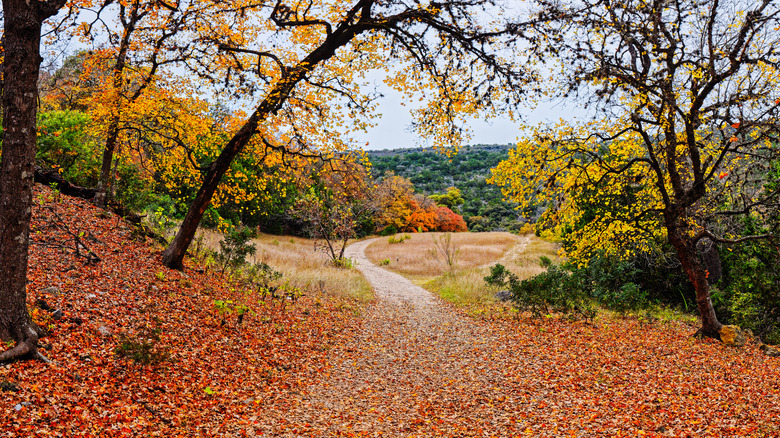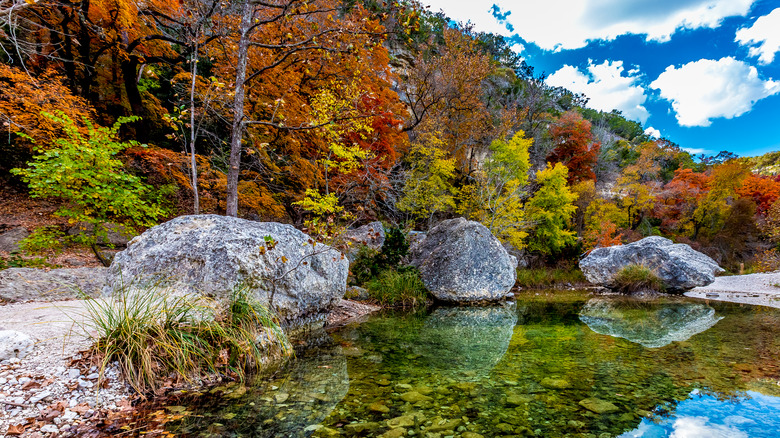Visit This Texas State Park For Stunning Fall Foliage Views
When autumn hits across the landscapes of Texas, one destination stands out as a masterpiece of fall foliage: Lost Maples State Natural Area. In the hill country region of Texas, this state park is one of the country's must-see fall getaways. What's better in the fall than changing leaves, crisp air, and a day of hiking? When October rolls around, Lost Maples State Natural Area gives visitors all three and more.
Lost Maples State Natural Area is home to a diverse array of tree species that offer a kaleidoscope of changing foliage during autumn. Visitors can expect constantly changing shades of red, orange, yellow, and gold as they explore the park's 2,174 acres. With over 11 miles of hiking trails, Lost Maples offers visitors plenty of opportunities to immerse themselves in the fall foliage.
The park's most popular hike during this time of year is the East Trail, a 3.1-mile difficult loop. It takes hikers through the limestone canyon, surrounded by the colors of the maple trees and towering rock faces. For those who prefer a shorter and less strenuous hike, there are several easier fall hiking trails ranging from 0.4 to 2.9 miles in length. Don't forget a sturdy pair of boots and some other fall hiking essentials, including extra layers, to make the most of your experience.
The trees that give Lost Maples its name (and color!)
Lost Maples State Natural Area is home to various tree species that display different hues throughout the season. The park's namesake, the Bigtooth maple tree, turns a vibrant red and orange during the fall months. The species typically grow in colder, higher elevations and are rarely found in Texas, as if they're "lost." Bigtooth Maples were thought to have been the only trees in the area to survive the last ice age and now thrive in the cooler canyons of Lost Maples.
Other prominent trees in the area include bald cypressand Texas red oaks. Altogether, these species of trees create the fall spectacle that Lost Maples is known for.
Visitors can also spot Texas madrone trees. This distinct species is known for its striking red bark, bright green leaves, and red berries in the fall. Additionally, sycamore trees line the Sabinal River that runs through the park, offering a beautiful contrast of golden leaves against the clear blue water.
The best time to witness the fall color palette
The magic of Lost Maples truly comes alive during the peak foliage season, which typically occurs from mid-October through early November. However, nature's schedule isn't set in stone, so it's essential to monitor local weather conditions and foliage reports. The park's official website and social media channels often provide real-time updates to help you plan your visit.
Fall foliage reports are also available from Texas Parks and Wildlife, which rates the color intensity of various regions in Texas. Reports come out annually beginning in mid-October and go back over the last 15 years of data. This is particularly helpful for out-of-towners who might not be familiar with the best viewing spots in the state.
To beat the crowds and secure a parking spot, plan to arrive around the time the park opens, at 8:30 a.m. on weekends and holidays, which are the busiest times at Lost Maples State Natural Area. Alternatively, consider visiting during the week to enjoy a more peaceful and secluded experience. The weekends tend to be more crowded, and with limited parking, it can be difficult to find a spot during peak times, especially during peak foliage season.


